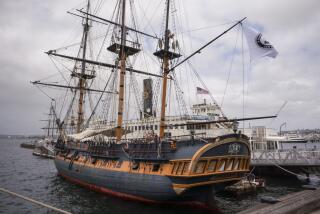Museum in Maine Takes a Bawdy Look at Sex Lives of Old Salts
BATH, Maine — The old photograph of a woman holding a stuffed bird to her breast is not the sort of fare usually found at the Maine Maritime Museum, a showcase of memorabilia from the golden age of sail.
The museum, normally a hushed place of artifacts from the days when commercial sailing ships were king, is offering a bold and slightly bawdy look at the sex lives of 19th-Century sailors.
“Sin, Sailors and Salvation: Seaport Seductions and Social Reform in the Age of Sail,” includes drawings and descriptions of waterfront bordellos and barrooms, as well as warnings on the dangers of vice in port.
The exhibit--a mixture of artwork, clothing, books and even a set of brass knuckles--paints a picture of a raucous life style but also seeks to portray how sailors of the time were ravaged by alcohol and sexually transmitted disease.
Cut Off for Weeks at a Time
Dr. Charles Burden, a founder and trustee of the museum, said sailors would go to sea for weeks at a time, cut off from friends, family and stable relationships. As voyages drew to a close, sailors became obsessed with spending their pay on the sex and liquor they would find in port.
One drawing shows sailors on a sandy tropical beach with women dressed only in grass skirts.
“The average voyage was anywhere from 2 weeks to 4 months, so by the time they got to shore they were very excited about the prospect of wine, women and song,” said Burden, a pediatrician.
“There were prostitutes and salesmen and barkeeps, and the sailors might get drunk and spend all their money in a couple of days. Then they would have to go to sea again just to be able to have a place to live.”
For many sailors, it was a cycle that would end in poor health, Burden said. Sailors eager to spend their money in a hurry would often end up beaten, robbed or jailed.
Many times, Burden said, the debauchery would end only when the sailor’s money ran out, and he signed on for another voyage. Then the pattern would begin again.
Syphilis and other venereal diseases were rampant among the sailors. Because there was no cure at that time for syphilis, infection generally meant deterioration and death.
“Ships would carry so-called ‘gonorrhea medicine,’ but it wouldn’t do any good,” he said.
Sailors spent their free time at sea practicing scrimshaw, the elaborate carving of bones and tusks. Some of the artwork got a little off-color. Several examples of pornographic scrimshaw were left out of the exhibit because they were considered too explicit.
“There were some objections,” Burden said. “There were concerns that if we were more explicit than we have been, we might have some problems, since we do have school children that come through here.”
Bordellos prospered in the last century, which prompted sailors’ aid societies to warn crewmen about dangers lurking ashore. One booklet in the museum’s display, entitled “Advice to Sailors,” warned of dishonest shopkeepers, landlords and grog shop operators.
“But there is still another danger on land against which I must warn you,” the booklet said. “It is that which arises from bad women. It is difficult to say which ruins most sailors, drunkenness or badness.”
More to Read
Sign up for The Wild
We’ll help you find the best places to hike, bike and run, as well as the perfect silent spots for meditation and yoga.
You may occasionally receive promotional content from the Los Angeles Times.






